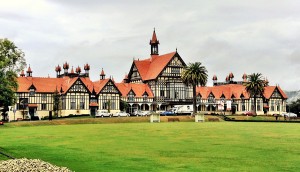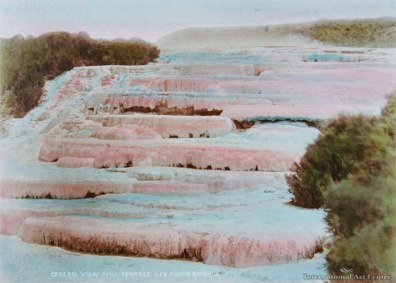Tagged: pink and white terraces
the coolest hot spot around, part 2
It seems I left you hanging on the edge of your seats a few days ago, having tantalized you with some of Rotorua’s wonders before coolly ditching you for brevity’s sake. What a flirt! But you know I can’t stay away for too long – not when there is still so much to tell you about!
 I left off having told you about the Bath House building being reinvented as a popular Rotorua nightclub for 25 (often crazy) years, until 1990 when the lease expired, ending another era in the building’s history. Yet, the Bath House was far from dead. 1969 saw the south wing become home to the City of Rotorua Museum, joined 8 years later by the Rotorua Art Gallery moving into the north wing. Growing it into the must-see attraction it is today was a slow transition involving many expansions, additions, and upgrades over the last 45 years, but the result has been very worth it. I was there for over 4 hours (including the free 1-hour guided tour) and didn’t come close to seeing everything.
I left off having told you about the Bath House building being reinvented as a popular Rotorua nightclub for 25 (often crazy) years, until 1990 when the lease expired, ending another era in the building’s history. Yet, the Bath House was far from dead. 1969 saw the south wing become home to the City of Rotorua Museum, joined 8 years later by the Rotorua Art Gallery moving into the north wing. Growing it into the must-see attraction it is today was a slow transition involving many expansions, additions, and upgrades over the last 45 years, but the result has been very worth it. I was there for over 4 hours (including the free 1-hour guided tour) and didn’t come close to seeing everything.
A big part of that might be because I spent so much time in the “Beating Hearts of Te Arawa” exhibit. It dove into the stories, customs, and taonga (treasures) of the Te Arawa Māori tribe, the first people to inhabit the area – following their mythological Hawaiki origins to their roots in the Rotorua area today.
One of the stories the exhibit dove into was the June 10, 1886 volcanic eruption of Tarawera Mountain, the most destructive volcanic event in New Zealand’s recorded history. In the early-morning hours of that day the explosion killed 153+ people, buried what many called the “Eighth Wonder of the World”, and generated a 17km long zipper of ripped-open rock along the top of the Tarawera mountain range, spewing fire and black smoke 9km into the atmosphere and re-creating Lake Rotomahana into a basin seven times its original size. The blast, reports say, was felt as far as Christchurch, almost 700km away.
 The “Eighth Wonder of the World” refers to the Pink and White Terraces of Rotomahana – dazzlingly beautiful steps cascading down the mountain like ornamental fountains, the largest silica terraces the world had ever seen. By the second half of the 19th century, they had become a popular destination for the wealthy (despite the arduous efforts it took to reach them) as news their grandeur spread. However, all that changed overnight with the violence of the Tarawera eruption. The terraces, directly in the fault zone, were buried under 60m of basalt and water when the bed of Lake Rotomohana gave way. Initially they were thought to have miraculously survived, but 5 days later, a telegram sent by the Rotorua postmaster announced the devastating news that it was “quite a decided fact that the terraces exist no longer.” It wasn’t until 2011, when scientists sent robotic submarines deep into the lake basin, that they found remnants of the terraces thought lost forever, a discovery of such significance that it has been dubbed New Zealand’s version of the discovery of the “Titanic”.
The “Eighth Wonder of the World” refers to the Pink and White Terraces of Rotomahana – dazzlingly beautiful steps cascading down the mountain like ornamental fountains, the largest silica terraces the world had ever seen. By the second half of the 19th century, they had become a popular destination for the wealthy (despite the arduous efforts it took to reach them) as news their grandeur spread. However, all that changed overnight with the violence of the Tarawera eruption. The terraces, directly in the fault zone, were buried under 60m of basalt and water when the bed of Lake Rotomohana gave way. Initially they were thought to have miraculously survived, but 5 days later, a telegram sent by the Rotorua postmaster announced the devastating news that it was “quite a decided fact that the terraces exist no longer.” It wasn’t until 2011, when scientists sent robotic submarines deep into the lake basin, that they found remnants of the terraces thought lost forever, a discovery of such significance that it has been dubbed New Zealand’s version of the discovery of the “Titanic”.
The Pink and White Terraces were close to each other (800m apart), having been formed over the years by boiling hot geysers, rich with silica, waterfalling down the hillsides and crystallizing as the water cooled, in time creating a beauty said to have been without equal.
“Set in a basin of pure white silica, delicately carved and fretted, lay a pool of pale blue water so pure in colour, so opaque in substance, I wish I could convey to the sight of those who read this the merest reflection of that heavenly colour, that pale tint found nowhere else on earth.” – Mrs. Howard Vincent
“To convey an idea of its beauty on paper is impossible.” – Lt. Herbert Meade, 1870.

The White Terrace (Te Tarata = “the tattoed rock”) was the larger and prettier of the two terraces, measuring 15 stories high and 2 football fields wide at the bottom.

The Pink Terrace (Otukapuarangi = “fountain of the clouded sky”) was where most people went to bathe due to the more moderate water temperatures. Hues ranged from pale pink at the 23m-wide bottom to smoked salmon at the top.
For more information on the re-discovery of the terraces, including photos of what they found, check out this blog by a man with ties to the 2011 scientific expedition.
 One area of the Museum I didn’t get enough time to take in as deeply as I would have liked was “Ake! Ake! – the story of B Company 28 Māori Battalion“, the unit of Māori soldiers whose World War II exploits in Greece, Crete, N. Africa, and Italy have become legendary. Known as a fierce and fearless, their determination to serve took them to the frontlines of some of the war’s worst fighting. One in six men was killed in active service.
One area of the Museum I didn’t get enough time to take in as deeply as I would have liked was “Ake! Ake! – the story of B Company 28 Māori Battalion“, the unit of Māori soldiers whose World War II exploits in Greece, Crete, N. Africa, and Italy have become legendary. Known as a fierce and fearless, their determination to serve took them to the frontlines of some of the war’s worst fighting. One in six men was killed in active service.
“We’ll fight right to the end. For God! For King! And for Country! Ake, ake, kia kaha e!” – WWII marching song written for the 28th Māori Battalion
In a bit of a personal spin on this story, one of the British tourists in the guided tour group I was in told how her father’s best friend witnessed the B Company in action. When faced by an approaching unit of German soldiers, they broke out in the Haka (Māori war dance), intimidating the Germans so badly they fled their positions. That’s the stuff that makes legends.
 It was a good thing that the Museum closing time came when it did, because I had just enough time to race back to the hostel to meet the driver from the Mitai Māori Village where I had signed up for (at the recommendation of a friend) a staged evening of entertainment focusing on Māori stories, songs, dances, and kai (food). I must admit, I usually avoid the more costly, “slick brochure” touristy stuff – especially when it costs more than an average dinner out with friends – but Mitai?… worth. every. penny. What a fantastic evening! It entertained, it informed, it fed – incredibly well on all 3 fronts.
It was a good thing that the Museum closing time came when it did, because I had just enough time to race back to the hostel to meet the driver from the Mitai Māori Village where I had signed up for (at the recommendation of a friend) a staged evening of entertainment focusing on Māori stories, songs, dances, and kai (food). I must admit, I usually avoid the more costly, “slick brochure” touristy stuff – especially when it costs more than an average dinner out with friends – but Mitai?… worth. every. penny. What a fantastic evening! It entertained, it informed, it fed – incredibly well on all 3 fronts.
After being welcomed by our hilarious host – who during the “where is everybody from?” time incredibly managed to exchange a few words of greeting with the guests from each nation in their native language (even the more obscure Lithuanian, Belgian, and Danish ones) – we were taken on a walk into the bush to meet the Māori warriors coming down the stream in an ancient waka (canoe). From there it was on to the open theatre for the show where the “tribe” put on a superb performance of traditional songs and dances, including a haka, followed by an engaging and often humorous lesson in Māori history, customs, and culture by the chief.
And then there was the hāngi dinner, a delicious and plentiful meal slow-cooked over heated rocks buried in a pit in the ground. I should have taken a photo of that. You wouldn’t have believed the spread!
The evening ended with a night walk through the indigenous flora and fauna to the glowworm pool before being taken back to the hostel for one last sleep before heading back to Napier the next morning. What a memorable way to end my visit there. And at the risk of sounding like an informercial, if you’re ever in Rotorua, check out what the Mitai family has put together. You won’t regret it.
I could have easily spent a few more days in the city discovering its many offerings – simply the unique geothermal experiences the area supplies could have made for a couple of happy days of exploring – but with the seaside magic of Napier calling me back, I can’t say I was particularly sad to leave Rotorua behind… at least not its sulphuric odor which hadn’t lifted in the few days I was there. However, its odd perfume aside, Rotorua itself should be a mandatory destination for anyone who comes to New Zealand. You have to see it to believe it.
Until next time!
Extra photo credits:
White Terrace painting
White Terrace photo
Pink Terrace photo
B Company 28 Māori Battalion
Rotorua – geothermal

